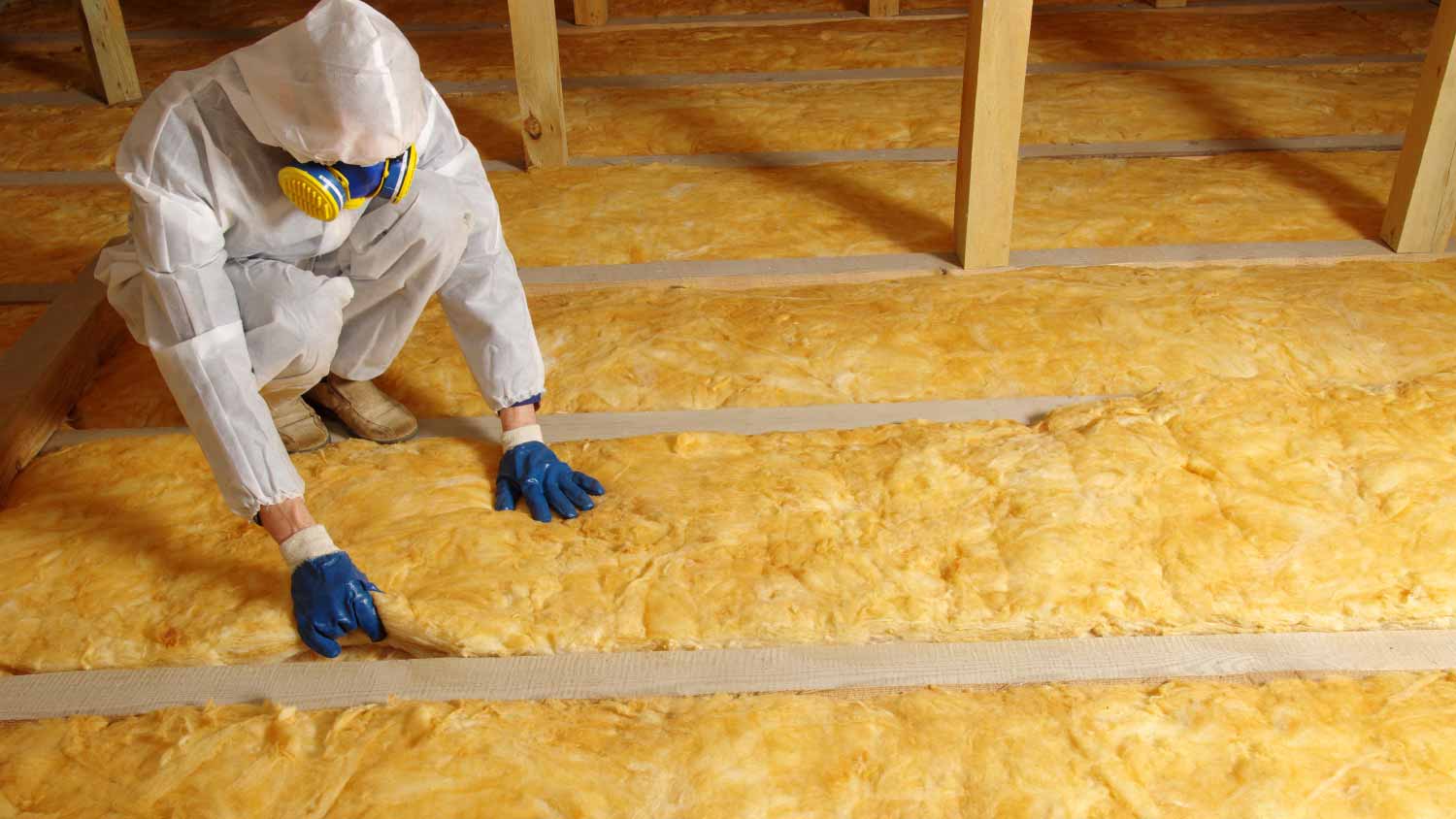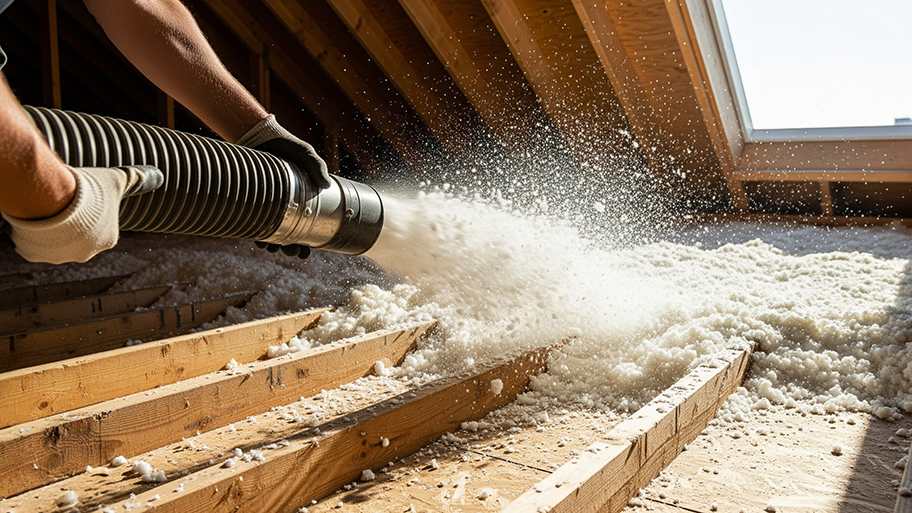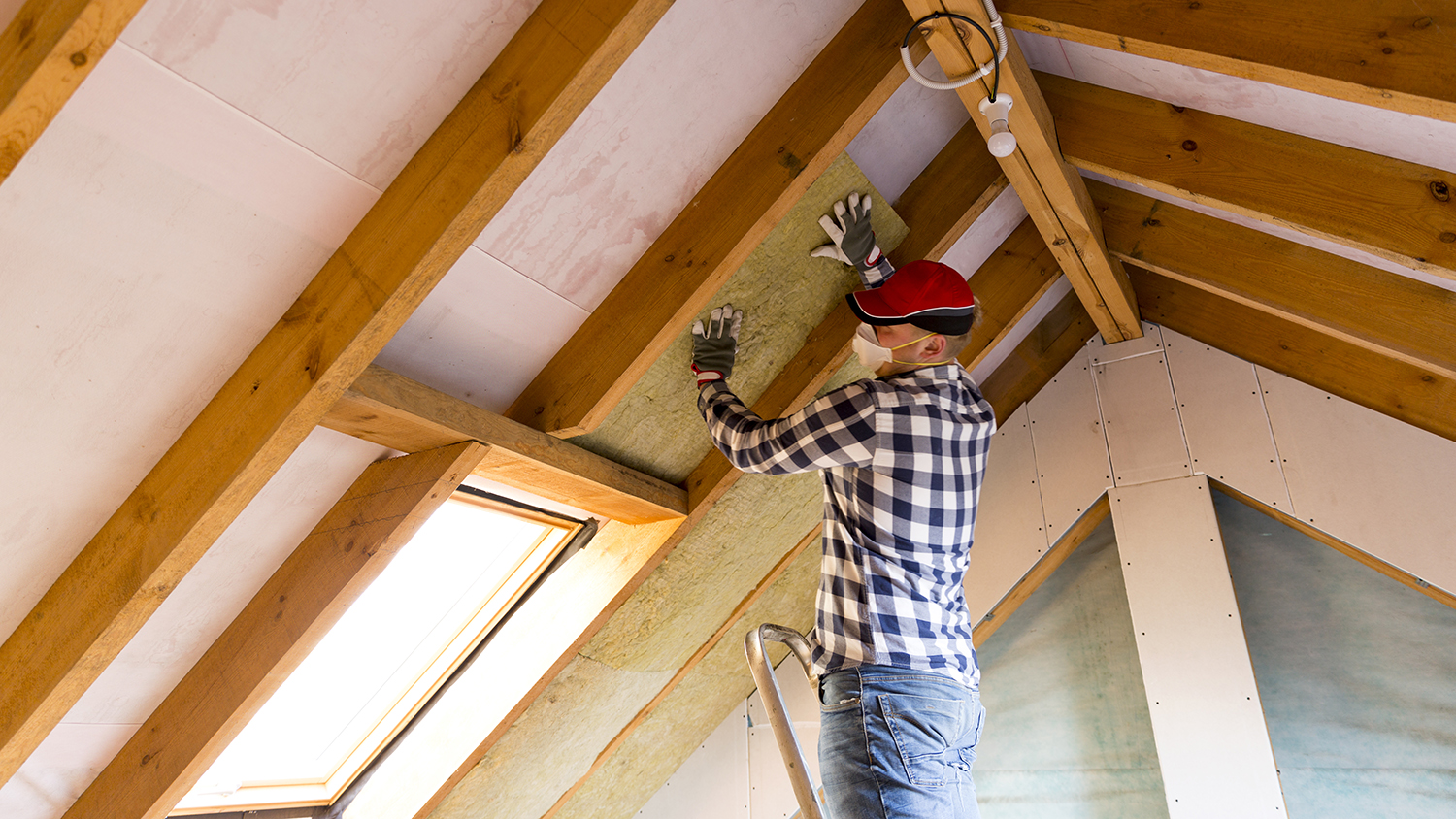
The cost to insulate a basement varies based on materials, size, and other factors, as well as how much of the work you wish to perform yourself.
Warm up to insulation's many types and benefits


Insulation is made from materials like cellulose, polyurethane, and fiberglass.
Good insulation maintains comfortable interior temps and lowers energy bills.
Blown-in, spray foam, and batt and roll are three of the most common insulation types.
If you're a homeowner, you've likely heard of insulation. But it's fair to ask: what is insulation, exactly? Insulation is a material placed in your walls, attic, ceilings, floors, and other areas to resist heat flow and prevent hot air from entering your house in the summer and sneaking out in the winter. It's critical for keeping your home at a comfortable temperature all year round. If your home is poorly insulated, you'll notice it's too hot or too warm, and your energy bills may be higher than they should be.
There are many different types of insulation, though. Use this guide to understand the fundamentals of this essential home feature, including how the different options work and what you need to know to pick the right one.
Insulation is a type of building material that helps regulate a home's interior temperature. The right insulation will help homes stay warm in the winter and cool in the summer, so it can improve a home's energy efficiency and comfort while reducing your monthly energy bills.
Essentially, insulation reduces the rate at which heat transfers. In a home, heat naturally flows from warmer areas to cooler areas, so in the summer, heat will move inside the home, and during the winter, heat transfers outside. However, proper insulation can act as a barrier, reducing the flow of heat and helping to regulate the interior temperature.
There are three different modes of heat transfer, which can inform what type of insulation you need.
Conduction refers to the process of heat transferring through solid materials. For instance, if you touch a hot pan, you'll feel its heat due to the conduction process. Most insulation comprises small pockets of trapped air or gas. These pockets slow down the conduction process because both air and many gasses are poor heat conductors.
Convection refers to the movements of liquids and gasses in response to heat. When the air becomes warm, its density decreases, and the air rises; when the air becomes cold, its density increases and the air falls. Proper insulation can prevent convective heat loss by trapping the air and preventing it from moving up or down.
Radiation refers to the transfer of heat via electromagnetic waves. In other words, it's the heat you feel when you're in the sun. Some insulation materials, such as radiant barriers, are designed to reflect radiant heat away from the surface, minimizing how much the radiant heat will warm the space. Radiant barriers are often used in attics and other spaces that receive lots of sunshine.
The effectiveness, or strength, of insulation is indicated by the insulation's thermal resistance, aka the R-value. The higher the R-value, the better the insulation material is at slowing down the transfer of heat. The minimum R-value that you'll need depends on what space you're insulating, as well as where in the country your home is located.
For instance, if your home is located in a very cold region and you're insulating a drafty space like an attic, you'll likely need insulation with an R-value of R49 or higher.
| Insulation Type | Material | Benefits |
|---|---|---|
| Batt and roll | Fiberglass, mineral wool, plastic and natural fibers | Easy to install and high R-value |
| Spray foam | Polyurethane | Highest R-value and water resistant |
| Blown-in | Cellulose, fiberglass, mineral wool | Inexpensive and fire-resistant |
| Radiant barrier | Reflective materials, aluminum | Lowers cooling needs |
| Rigid foam board | Polystyrene | Soundproof and low starting costs |
| Structural insulated panels | Polystyrene or polyurethane | Highly durable and airtight |
There are several insulation options, many of which come in different shapes and materials. The type you'll need largely depends on your home and the particular space you're insulating.
Batt and roll insulation comes in rolls or rectangular panels that are designed to fit between wall studs, attic trusses, and rafters. This insulation is often made of fiberglass, but you can also find batt and roll insulation made of mineral wool, plastic fibers, and natural fibers.
Spray foam insulation is a liquid foam that expands and hardens once it's applied. The ability to go from a liquid to a solid makes it ideal for small and irregular spaces, like wall cavities and attics. There are two types of spray foam insulation: Open-cell foam and closed-cell foam. Open-cell foam is more flexible and expansive, making it ideal for large spaces. Closed-cell foam is denser and has a higher R-value.
Blown-in insulation is applied using a device that blows insulating particulates into attics, wall cavities, and other spaces. It comes in several materials, including cellulose, fiberglass, and mineral wool. Its ability to be blown into different spaces makes it a good fit for irregularly shaped areas. For that reason, it's often used for retrofitting older homes with insufficient or drafty insulation.
A radiant barrier minimizes radiant heat transfer, which is the heat from the sun. However, a radiant barrier won’t help your home maintain heat during the winter, so you’ll need to pair it with traditional insulation if you live in a climate that experiences cold temperatures. Composed of reflective foil surfaces like aluminum, it reflects rather than absorbs heat. These barriers are often installed in attics and other spaces subjected to lots of sunshine to reduce cooling costs.
Rigid foam board insulation is strong and dense. It typically comes in panels made from different foam materials, such as polystyrene, extruded polystyrene, or polyisocyanurate. Their density and thickness give them high R-values, and they're most often used for exterior sheathing and under concrete slabs. In addition to insulating spaces, they can also act as vapor and moisture barriers.
Structural insulated panels are made of foam sandwiched between structural facings, which are usually made of oriented strand board or plywood. Their strong form provides both insulation and structural strength, so they're often used as building materials for walls, roofs, and floors.
How you install insulation depends on the type you select. For instance, some materials are easier to DIY than others—like blown-in options, which are designed specifically for reaching into tight areas without the need for demolition. To install blown-in insulation, you simply need to create a small hole in your wall, slide the end of a hose in, and turn on the blowing machine.
On the flip side, you’ll need to bring down the walls to install options like structural insulated panels. Spray foam installation also has health considerations, so it’s a job best left to a pro who has specialized experience. Find out who installs insulation so they can take this kind of work off your plate.
Insulation brings many benefits, particularly when it comes to comfort and energy efficiency. The main benefits include:
Energy Efficiency: Since insulation minimizes heat transfer between the interior and exterior of a home, less energy is needed to heat or cool the home. How much insulation reduces energy bills depends on the type you choose and its R-value. In general, though, the higher the value, the more you can expect to win back.
Comfort: Insulation helps to regulate the interior temperature, reducing drafts and hot spots and making the home feel more comfortable.
Soundproofing: Insulation can also act as a sound barrier, reducing how much outside noise you hear as well as the noise between rooms.
Environmental Impact: Since insulation improves a home's energy efficiency, it also reduces energy consumption, thereby reducing your carbon footprint.
Reduced Strain on HVAC Systems: HVAC systems don't need to work as hard in a well-insulated home, which reduces their strain and potentially prolongs the lifespan of the system.

For most homeowners, insulation costs between $1,000 and $2,600 to install. But these figures vary quite a bit depending on how much insulation you need and what type. For a better idea of the cost, reach out to a local insulation company. The room in your home where you're installing insulation can also affect costs. For instance, installing insulation in an unfinished attic usually costs more than installing it in other areas because most attics are drafty and require more insulation material than other rooms in the home.
From average costs to expert advice, get all the answers you need to get your job done.

The cost to insulate a basement varies based on materials, size, and other factors, as well as how much of the work you wish to perform yourself.

The cost of blown-in insulation costs varies depending on the type of insulation, labor, prep work, and more. Learn more about the cost factors in this guide.

Discover roof insulation costs, including average prices, key cost factors, and expert tips to help you budget and save on your next project.

Asbestos-containing insulation is banned or restricted in many countries, but it's still found in some homes. Use this guide to identify if you have the hazardous material in your home.

The best insulation for your basement depends on the insulation location, budget, and climate. Here’s what you need to know about insulation for basements.

How to decide if you should add insulation to your attic floor or ceiling to make your home more efficient